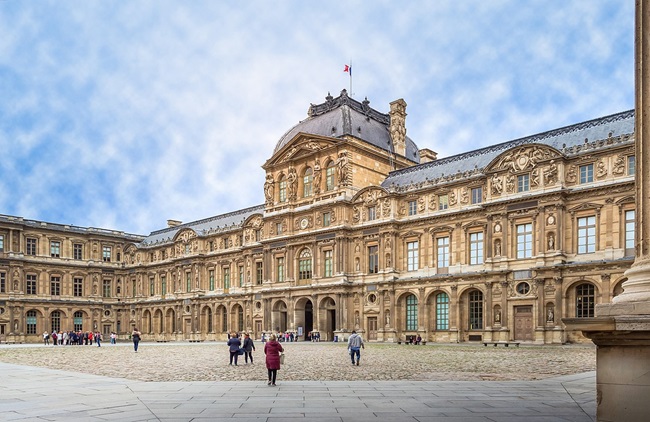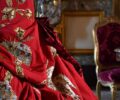The Louvre Renaissance and Louvre Couture: News from the Palace of Art

- SUBSCRIBE
- ALREADY SUBSCRIBED?
BECOME A BONJOUR PARIS MEMBER
Gain full access to our collection of over 5,000 articles and bring the City of Light into your life. Just 60 USD per year.
Find out why you should become a member here.
Sign in
Fill in your credentials below.
At the most visited museum in the world, there are innumerable masterpieces at every turn. The Louvre houses works of genius including the Leonardo’s Mona Lisa, the Venus de Milo, and Delacroix’s Liberty Leading the People. Today, Laurence des Cars, director of the Louvre, is leading the charge to a new era for the museum.
Though originally built as a fortress in the late 12th century, before becoming a sprawling palace of French kings, the Louvre is now vulnerable. Management, staff, and visitors agree that the building is in serious need of some TLC. In a letter to the French Ministry of Culture, Madame des Cars highlighted how conditions inside the museum have become increasingly difficult, with visitors lacking space to rest, insufficient food services, and restroom facilities. A recent spontaneous strike by overwhelmed staff is indicative that the historical site is a victim of “overtourism.”
There are serious maintenance issues, and the Louvre’s staff worries about the risk of damage in the exhibition spaces. Paris remembers the flood of 2016, when 35,000 artworks at the Louvre were quickly wrapped, bundled, and transported to higher floors of the building. Some areas are no longer watertight. It’s not unusual, nor acceptable, to see buckets catching drips in the public galleries on rainy days. Other parts of the building experience significant temperature fluctuations. De Cars letter also pointed to climate control issues, describing a greenhouse effect inside the glass Pyramid entrance.
French President Emmanuel Macron all but saved Notre Dame, and perhaps he feels it incumbent on him to save the Louvre too. In a speech given in front of the Mona Lisa, Macron said, “In an era where immediacy and forceful rhetoric hold hypnotic power over so many, speaking about the long term, about culture and art, is, I believe, one of the messages that France must convey to the world.”

Louvre pyramid. Photo: Benoit photography/ Flickr
Macron’s project, dubbed Louvre Nouvelle Renaissance (“Louvre New Renaissance”) is a Louvre, he said, “reimagined, restored and expanded.” The museum will remain open during these colossal renovations, which will probably run to more than €800 million. The aim, Macron said, is to bring the museum up to modern standards in a time of international mass tourism, heightened security requirements, and climate change.
As part of the “New Renaissance” renovation, an international architecture competition will be launched and winners selected by the end of 2025. What is compulsory for architects tendering for the prize is the creation of a new entrance and a new home for the Mona Lisa.
A second entrance will be created at the Colonnade de Perrault on the Louvre’s eastern façade to ease the strain on the pyramid designed by architect I.M. Pei and inaugurated in 1989. It was originally designed to accommodate an annual 4 million visitors, the museum now welcomes 9 million, and aims for 12 million visitors per year in the renovated Louvre.

Mona Lisa by Leonardo da Vinci.
The Mona Lisa painting would be given its own special home within the Paris museum, independently accessible from the rest of the museum, with its own ticketed space.
Macron explained that the reno won’t be a burden on the French taxpayer. To help pay for the work, ticket pricing will change; visitors from outside the European Union will have to pay more for admission starting in 2026.

The Louvre Palace. Photo Credit: Ali Sabbagh/ Wikimedia Commons
Once the wrinkles are ironed out, and the current work action is resolved, perhaps book a timed ticket to see the exhibit, Louvre Couture: Objets d’art, Objets de Mode, because after all, the Louvre is always a good idea.
By juxtaposing key pieces from the Louvre’s collection with masterpieces of contemporary haute couture, the exhibition has incongruously placed over 100 examples of designer fashion throughout an exhibition space containing decorative arts dating from the Byzantine period to the 1870s.

Yves Saint Laurent, Louvre Couture. © Musée du Louvre – Nicolas Bousser
Olivier Gabet, the curator of Louvre Couture, advocates displaying fashion alongside painting, sculpture, and objets d’art. As the head of the Decorative Arts Department at the Louvre, Gabet aptly describes the museum as “the biggest mood board in the world.” Art historians know that through the centuries, aspiring artists have come to the Louvre to copy the masters and develop their own style. It was a rite of passage for French students of fine art – move to Paris and copy at the Louvre. Paul Cézanne said that “the Louvre is the book from which we learn to read.” And the Louvre is an eloquent storyteller.

Forty-five exemplary fashion houses have loaned pieces to the Louvre, dating from the 1960s to 2025. The exhibit, designed by Nathalie Crinière, is structured around several main historical periods, which visitors are free to explore in any way they choose. Following the path through the galleries is like a treasure hunt for fashion, trailing carefully through the Louvre’s existing structure, making use of the museum’s niches, glass cabinets, and architectural details.
Fashion designers were also motivated by the Louvre. Some of the greatest couturiers have created their own pastiches, echoing the painting and sculpture found in the museum. Due to their knowledge of art, some designers can be extremely literal in their references. Yves Saint-Laurent wandered the galleries for hours, borrowing from the splendor of the Middle Ages for his silhouettes. More recently, Jeremy Scott for Moschino designed a silk moiré dress that comically mimics an 18th-century chest – the result resembles something from Beauty and the Beast. Dutch designer Iris van Herpen’s gothic Cathedral dress resembles a wooden altarpiece. It looks as uncomfortable as a crown of thorns but it is made from 3D polyester.
While some fashion designers seem to cite Louvre’s collections directly, others don’t. Yet Gabet and Crinière see the conjunction and coincidence between the mannequin and the museum.
On a skirt suit – already derived from Chanel – Jean-Charles de Castelbajac has created what is referred to as “medieval camouflage Bambi.” The cartoon deer is patched onto a background of embroidered foliage, reminiscent of the 15th-century tapestry it stands before. A bizarre headdress with a soft set of antlers further enforces the plush toy theme.

Alexander McQueen, Louvre Couture. © Musée du Louvre – Nicolas Bousser
Alexander McQueen’s Armadillo shoe, made from snakeskin, is placed alongside the curious fish and reptile ceramics of 16th-century artist Bernard Palissy. Essentially, both are disconcerting and a connection is made between the two.
The metallic Trophy Purse, a Louis Vuitton bag by Nicolas Ghesquière, looks like it should be displayed in a vitrine with gauntlets and gorgets from the Renaissance. A chrome-plated dress by the House of Balenciaga evokes Joan of Arc. It makes no excuses – it’s an armoured dress. Three-D printed in galvanized resin and lined with velvet, it stands alongside Henry II’s 16th-century armor of steel, brass, and leather. Versace recalls the Crusades in a sexy medieval fall of liquid sequins embellished with crucifixes.
To me, Charles de Vilmorin’s papery taffeta dress resembles the Winged Victory of Samothrace standing on the Daru stairway. Dolce and Gabbana’s dress is iconic, literally imitating Byzantine mosaics, like those of Queen Theodora.

Charles de Vilmorin, Louvre couture. © Musée du Louvre – Nicolas Bousser
A velvet robe trimmed with ermine, designed by the controversial John Galliano for Dior, seems as if Josephine has exited Jacques-Louis David’s The Coronation of Napoleon to stand in the gallery.
As part of general admission, the Studio: Louvre Couture welcomes families and school groups to discover and interpret the fashion exhibition independently, in a fun and creative way. Activities include making your own haute couture pearl brooches inspired by those presented in the exhibition, embroidering your own card based on the meticulous examples in the Louvre. On the community loom, visitors can discover the art of weaving by drawing inspiration from the patterns on Rabih Kayrouz’s skirt, one of the fashions on display.

Jeremy Scott for Moschino (Fall/ Winter 2022–23) © Musée du Louvre – Nicolas Bousser.
The catalogue Louvre Couture and other books highlighting the richness of the museum’s collections are available in the boutique. Also in the boutique are a collection of objets d’arts, designed by artist Harry Nuriev, who was invited by the Louvre to create a collection of silver charms and objects, derived from the Decorative Art’s collections. The exhibition Louvre Couture is supported by Kinoshita Group and Visa Infinite.
Louvre Couture aims to appeal to a slightly different audience, one who might not necessarily appreciate the decorative arts collection for itself. Through the lens of fashion, increasingly prevalent in today’s popular culture, visitors are led to more historically complex works. Louvre Couture has been extended until August 24, 2025.
Lead photo credit : Versace at the Louvre. © © Musée du Louvre – Nicolas Bousser





